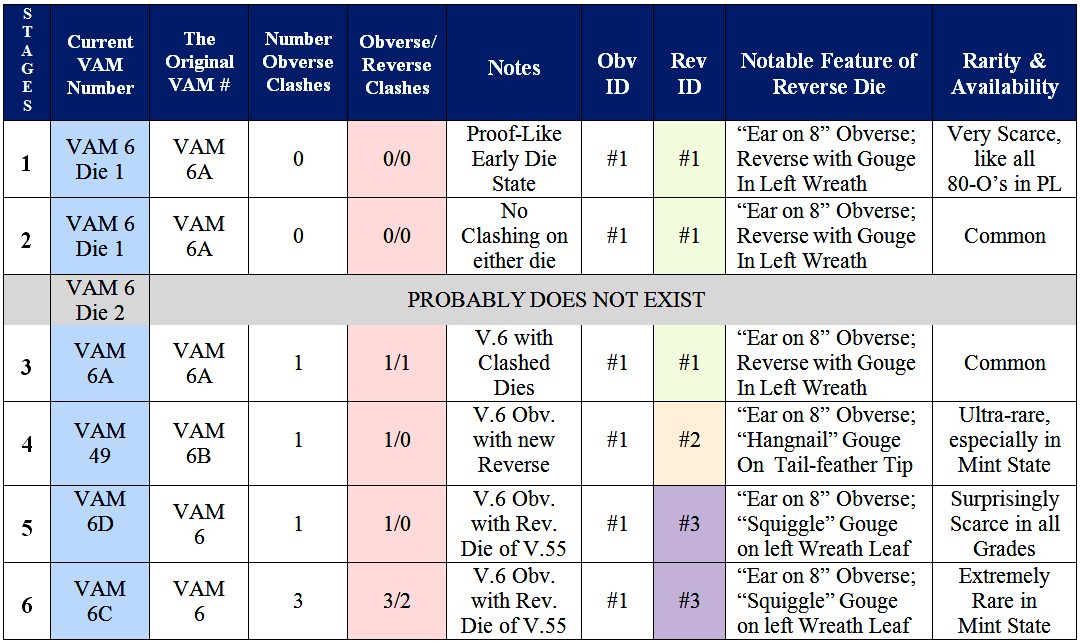-
- Coming Soon!
-
- Coming Soon!
-
- Coming Soon!
Research Reports
The 1880-O VAM 6 Die Progression
(Sequencing VAMs 6, 6A, 6B(49), 6C & 6D based on the Obverse Die)

Chart 1.3 There are six individual stages currently known for the 1880-O VAM 6 "8/7 Overdate" progression, and the fact that all share the same obverse die makes it possible to establish the actual striking sequence. The accompanying chart lays out the stages in the progression, using clashing episodes involving the obverse die as distinct markers for the sequence. This is a fascinating set of varieties, which starts as the VAM 6 with its unclashed, Proof-Like surfaces, and ends with the VAM 6C, which displays evidence of three conspicuous clashing events. For those who enjoy a little detective work, this progression is for you! Indeed, this chart attests to the fact that much more happens during the life of an individual die than most collectors realize!
The Six Stages of the VAM 6 Progression:
| STAGE 1: | The earliest die stage in the 1880-O VAM 6 progression, like all the overdate varieties in the set, displays an "8/7 Ear on 8" obverse, while the reverse shows a prominent die gouge in the left wreath. And because it is the starting point for the progression, the first stage, as would be expected, is unclashed, showing Proof-Like surfaces and exhibiting sharply detailed design features. | OBVERSE #1 REVERSE #1 |
| STAGE 2: | By Stage 2 the VAM 6 die pair from Stage 1 has begun to show signs of wear, and the reflectivity of the surfaces on the struck coins is all but gone. Since this die stage is quite common, it can be presumed that the die pair continued in the coining press without incident for a considerable stretch of time. But note that there’s still no evidence of clashing. | OBVERSE #1 REVERSE #1 |
| STAGE X: | The next stage in the sequence, as proposed by Van Allen, is the so-called "VAM 6, Die 2" variety. However, it can be seen in the above chart that the listing has been omitted. Why? After considerable research, no one has been able to independently corroborate the existence of the variety. Moreover, this anomaly is explainable by suggesting that the VAM 6 Die 2 designation is actually a misattribution of the VAM 6D. Time will tell! | Would have Obverse #1 and a different Reverse |
| STAGE 3: | After a long run in the coining presses, the VAM 6 die pair finally clashes, resulting in the VAM 6A designation. But the story doesn’t end there, as clashing rarely renders the dies unusable. In Stage 3, the die pair continues an extensive run in the coining press to the point that, together with Stage 2, it is one of the two most commonly encountered stages in the progression. | OBVERSE #1 REVERSE #1 |
| STAGE 4: | Late in its life span, this reverse die, identified by the "Gouge in the Left Wreath," was replaced in the coining press with an already used die, known as the "Hangnail Reverse." This new die combination created Stage 4 in the sequence, and has now been designated the VAM 49. Since the obverse was already clashed, it’s not surprising that there would be one clash on the obverse and none on the reverse. | OBVERSE #1 REVERSE #2 |
| STAGE 5: | In light of the rarity of Stage 4, it is likely that the "Hangnail Reverse" die lasted but a short time with the VAM 6 obverse die, at which time it was replaced with yet another reverse. This reverse is easily attributed by the irregular die scratch/gouge on the first leaf cluster in the left wreath. The change of the reverse die results in the third obverse/reverse die combination. | OBVERSE #1 REVERSE #3 |
| STAGE 6: | The last stage in this progression is the VAM 6C, which is the product of the same "Ear on 1st 8" obverse die and the preceding Stage 5 reverse. What’s noteworthy here is the presence of three distinct clash marks on the obverse and two on the reverse. And because Stage 5 showed only one clash mark on the reverse and none on the reverse, this final die stage must have clashed twice more. And there the sequence ends. | OBVERSE #1 REVERSE #3 |
Acknowledgments: The author wishes to thank John Coxe and John Baumgart for their invaluable input. Both men are respected experts in our field, and as always, their contributions have been helpful and constructive.
No part of this writing or presentation may be reproduced by any means without the written consent of the author.

 1878-CC Varities
1878-CC Varities 1878-S VAM Listings - Part 1 (VAMs 1 to 25)
1878-S VAM Listings - Part 1 (VAMs 1 to 25) 1926-S VAM 4 "Dot Variety" Die Progression
1926-S VAM 4 "Dot Variety" Die Progression The 1880-O VAM 6 Die Progression Study
The 1880-O VAM 6 Die Progression Study